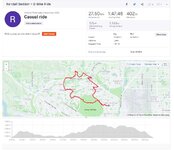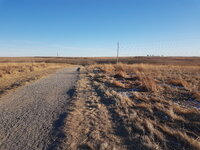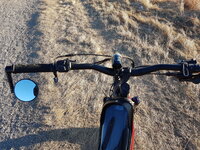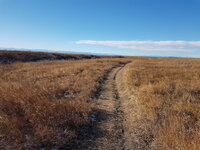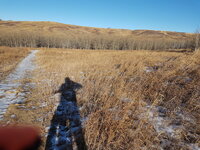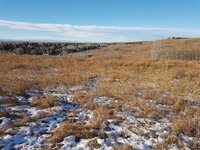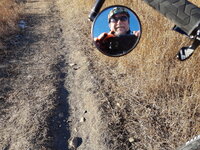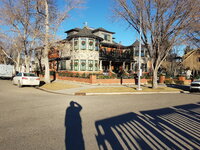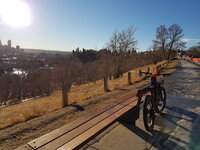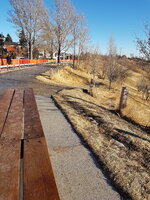There has been no snow in Virginia as yet this winter. Probably because the temps have been huddling close to the "average" of about 50°f (10°c) which, while allowing for any type of rain from gentle mists to drenching downpours, is a long way from the subfreezing temps necessary to produce the white stuff.
That doesn't mean it didn't feel like it could snow at any moment yesterday when I took my newly repaired LaFree out on the gravel roads, just a short 13 mile (21 k) spin around the block, for a private little reunion as a "welcome back home" after it had spent several weeks sitting in the bike shop waiting a new wiring harness. The original battery-to-motor wiring had been sliced through from 3,000 miles of rough gravel road riding aided by a poor design on Giant's part for having said wiring come through an unprotected raw hole cut in the rear metal fender. The new wiring was protected with a vigilant rubber grommet and a widened access hole in the fender, so the odds of the new suffering the same fate as the old was slim to null.

The overcast afternoon didn't have much to offer in the way of spectacular scenery, but the chilly wind and grouchy skies did promise some relaxing solitude as most intelligent people opted not to be out in the less than agreeable weather. It felt strange getting reacquainted with the slower LaFree after the faster Vado had been my sole ride for several weeks, but before long the bike and I had rediscovered our sync, and I could once again revelle in the sheer beauty of an utterly silent belt drive.
Thus we glided silently along the lonely rural roads, kept company only by the endless procession of centuries old stone walls, leafless trees, and cattle grazing far off in the fields under the watch of ancient mountains so old that their birth predated life on this planet. The sun struggled to cast enough light to even produce shadows, but the clouds would have none of it, crowding denser and denser in the sky, shutting off the brightness until everything below turned a uniform gray.
My phone camera finally gave up trying for some color, and simply resigned itself to capturing the landscape in shades of ochre and sienna.
Only once did my lens turn the sullen gray skies into a deep pastel blue, quite by sheer luck beautifully highlighting the formidable symbol of death silently perched on the crumbling chimney stack of an old abandoned and rotting dwelling tucked into the nasty embrace of decades old prickers and weeds and vines and enveloping woodlands.

Our rural roads have ample graveyards of these decrepit structures that are devolving back to the earth. You usually never see anything until the late fall when the trees drop their green barriers to reveal the secrets of the inner woods. According to the county records this house was built in 1953. The occupants, after taking loving care of the property as evidenced by a 1957 aerial photo showing a beautifully curved driveway and groomed fields, eventually walked off, never to return, sometime between 1958 and 2002. That timeframe - a gap in the county's aerial archives - went from a photo of pristine property to one that had been handed back to raw nature. The 2002 overhead photo showed a house surrounded by a growing woodland. The driveway was gone, overrun with scrub, and the carefully maintained field has succumbed to an uncultivated crop of trees that had encroached upon the house already. Each subsequent yearly aerial photo showed a progressively denser woods, and an increasingly frail building. The neighboring house adjacent was also sharing a similar fate of neglect and abandonment. What was once a thriving little community of houses and small plot farmlands at this bend of a rural road had become a graveyard of rotting structures left like tombstones to degrade into the soil that was now, once again, deeded back to the wilderness.
I plan to explore the lineage and owners of this property once the county offices once allow visitors to explore the old records.
Throughout the ride I noticed much of the local residential autumn decorations of bright orange pumpkins perched on hay bales or estate entry columns still remained in place, not yet supplanted by Christmas weaths and greenery decorations. The need to dress up for the final holiday of the season seemed to be lagging, a victim of the lethargy of pandemic exhaustion. Only one place had sufficiently summoned the Christmas spirit by planting a newly painted hitch wagon at their front entryway.

I stopped to take a picture, then walked up close to examine the vehicle. I actually was a bit horrified at seeing any carriage, even a lowly hitch wagon, left out in the elements, such careless disregard a sure way to literally encourage wood rot in less than week. Upon close inspection, however, the vehicle had already been rotting in several places, the buckled and splitting wood camouflaged by a fresh coat of paint and ropes of greenery. From a distance the vehicle looked quite nice, and very seasonal, as a Christmas display. I could imagine how festive it would look covered in snow.
But that wouldn't be the case for quite some time yet. The advance of the clouds was ample warning that an approaching cold front was on our doorstep, but this one would arrive in drenching rain, not the fluffy white stuff.
I arrived back home to see my neighbor across the road busy hanging a set of beautiful Christmas wreaths on the stone columns flanking his driveway entrance. At least someone other than myself is in the holiday mood I thought to myself as I looked up at our farm sign, the post quite seasonally draped in ropes of fresh greenery complete with red bows on the farm sign itself. All that was left was a dusting of snow to make the sign, and the surrounding countryside, magical.
Once the rains have come and gone, I'll keep my fingers crossed for a bit of snow next.




